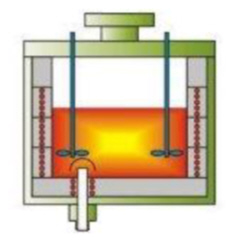Vitrification of Fission Products Issued from Reprocessing Used Nuclear Fuel at Orano La Hague Plant
AUTHOR
Khalil Ghaleb
Orano Federal Services
PRESENTING
March 12, 2025 - Entire white paper will be posted here
Waste Management Symposia
ABSTRACT

Reprocessing of used nuclear fuel (UNF) started in France in the 1950s. Currently, the Orano La Hague plant in Normandy, France, reprocesses around 1,000 MT a year of UNF in two facilities with a maximum combined capacity of 1,600 MT/year: UP3 (1990) and UP2-800 (1994).
The plant recovers uranium and plutonium for recycling into new reactor fuels. The structural wastes from used fuel assemblies (e.g., the end-fittings) are compacted into universal steel canisters called UC-C. Other technological waste arising from operating the facility are cemented and disposed of in a near-surface waste disposal facility. The fission products and minor actinides, by far the most radiotoxic, are vitrified into universal steel canisters (UC-V) identical in size to those used for structural wastes.
The vitrification workshops of the UP2-800 and UP3 reprocessing plants, R7 and T7 facilities, have given their name to the R7T7 glass. These facilities vitrify fission products and generate about 1,000 canisters a year. Since their commissioning, more than 24,000 canisters have been produced confining around 4 x 108 TBq of radioactivity.
Prior to vitrification, the concentrated solution of fission product coming from evaporators, as well as other waste streams, are blended and characterized. Calculating the right amount of chemical product needed and then adjusting the chemical composition accordingly is a crucial step towards producing the desired glass composition.
The mixed solutions of fission products and additives are then fed directly into a rotating calciner heated by electrical resistance. The dissolution fines and the vitrification off-gas system scrubbing solutions are also fed into the calciner, and apart from some platinum group metals (PGM), most of the fission products are converted to their oxide form. The calcine exiting the calciner is mixed with a specified amount of glass frit and fed into an inductively heated, oval-shaped, metal crucible. Every 8 hours, the glass is poured through a siphon-equipped bottom nozzle into a stainless-steel canister in batches of 200 kg (2 per canister).
After cooling, the canisters are transferred and sealed by a plasma torch welding machine and externally decontaminated before being transported for interim storage.
Orano has adopted an induction melting technology using a relatively small metallic melter inside a hot cell. This allows for the periodic shutdown of the system, remote maintenance activities, and the ability to replace equipment. The reasoning behind that choice was to minimize interruptions during normal operations, ensure reliability, and sustain a continuous production under the challenging conditions associated with handling of fission products.
Orano’s vitrification process is without doubt distinguishable from large joule-heated ceramic melters that require redundant uninterrupted power supplies, highly reliable equipment, and offering limited possibilities for maintenance, especially regarding the replacement of the melter itself. Nonetheless, being of a smaller scale, Orano’s melter technology requires implementing several parallel vitrification lines to reach La Hague’s required throughputs. Currently, six lines are installed with each line designed for a production rate of 25 kg/hour (55 lb/hour). By design, the equipment in these lines are consumables and replaceable after a specified service life.
After cooling, the canisters are transferred and sealed by a plasma torch welding machine and externally decontaminated before being transported for interim storage.
In this communication, the reprocessing at La Hague of UNF will be presented with focus on describing the vitrification process of fission products. In addition, the advantages associated with the use of a smaller equipment setup that are easier to remotely maintain and replace will be covered, as well as lessons learned from more than 35 years of operation.
>> Return to Orano White Papers
